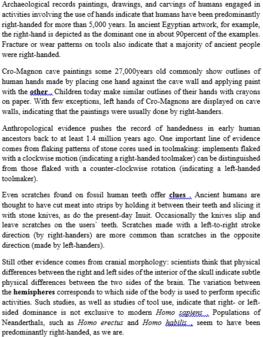Read the following passage and mark the letter A, B, C, or D on your answer sheet to indicate the correct answer to each of the questions from 35 to 42.
Clara Barton became known as “The Angel of the Battlefield” during the American Civial War. Born in Oxford, Massachusetts in 1821, Clara Barton’s interest in helping soldiers on the battlefield began when she was told army stories from her father. Another event that influenced her decision to help soldiers was an accident her brother had. His injuries were cared for by Barton for 2 years. At the time, she was only 11 years old. Barton began teaching school at the age of 15. She taught for 18 years before she moved to Washington, D.C. in 1854.
The civil war broke out 6 years later. Immediately, Barton started was service by helping the soldiers with their needs. At the battle of Bull Run, Clara Barton received permission from the government to take care of the sick and hurt. Barton did this with great empathy and kindness. She acknowledged each soldier as a person. Her endurance and courage on the battlefield were admired by many. When the war ended in 1865, she used 4 years of her life to assist the government in searching for soldiers who were missing during the war.
The search for missing soldiers and years of hard work made her feeble physically. In 1869, her doctors recommended a trip to Europe for a rest. While she was on vacation, she became involved with the International Red Cross, an organization set up by the Geneva Convention in 1864. Clara Barton realized that the red Cross would be a big help to the United States. After she returned to the United States, she worked very hard to create an American red Cross. She talked to government leaders and let American people know about the Red Cross. In 1881, the Notional Society of the Red Cross was finally established with its headquarters in Washington, D.C. Clara Barton managed its activities for 23 years.
Barton never let her age stop her from helping people. At the age of 79, she helped flood victims in Galveston, Texas. Barton finally resigned from the Red Cross in 1904. She was 92 years old and had truly earned her titled “The Angel of the Battlefield”.
What can be inferred about the government?
A. It did not always agree with Clara Barton
B. It did not have the money to hep Clara Barton
C. It showed Clara Barton great empathy and kindness
D. It had respect for Clara Barton



Đáp án D
Điều gì có thể suy ra về chính phủ?
A. Không phải luôn đồng tình với Clara Barton
B. Không có tiền đề giúp Clara Barton
C. Dạy cho Clara Barton sự thấu cảm và sự tử tế
D. Tôn trọng Clara Barton
Dẫn chứng: “She talked to government leaders and let American people know about the Red Cross. In 1881, the Notional Society of the Red Cross was finally established with its headquarters in Washington, D.C. Clara Barton managed its activities for 23 years.”